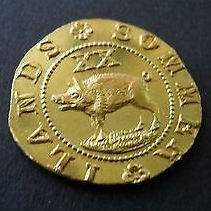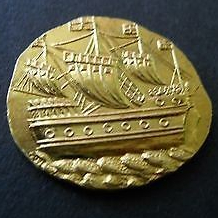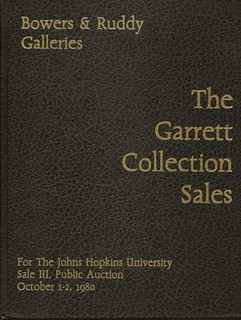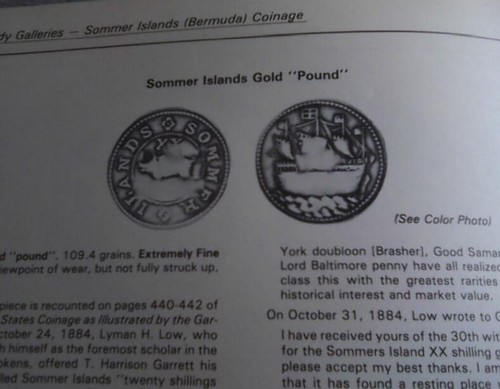
PREV ARTICLE
NEXT ARTICLE
FULL ISSUE
PREV FULL ISSUE
V25 2022 INDEX E-SYLUM ARCHIVE THE SOMMERS ISLAND FRAUDMike Costanzo submitted this article about the fantasy Sommers Island gold pound. Illustrated is a modern example struck from dies originally created by Wuesthoff in the early 1880's. -Editor
Lyman Low, T. Harrison Garrett, and the Sommers Island Fraud
From 1979 to 1981, Bowers & Ruddy Galleries sold the outstanding collection of
T. Harrison Garrett in four highly celebrated auctions. Among the 2,453 lots was a
highly questionable purchase made by Garrett in 1884 from dealer and future
author Lyman H. Low. The coin in question was a Sommers Island
On October 24, 1884, Lyman Low wrote to Garrett offering him the
On October 29th, Low followed up with yet another letter concerning the piece
and claiming it arrived from Germany with The Sommers Island gold piece remained in Garrett's collection well after Garrett's death in 1888 and continued to reside among later additions made by Garrett's sons, Robert and John Work. The John Hopkins University would later inherit the collection and eventually put the contents up for auction.
Bowers & Ruddy listed the piece as a
The Sommers Island Gold Pound as it appeared in the Bowers & Ruddy auction
listing.
Low, however, appeared to be pushing the piece on Garrett by writing two letters
in five days extolling the rarity of the coin, before successfully closing the sale
within the span of a week. Low also failed to mention the fact that the piece was
previously mentioned in Edouard Frossard's Numisma, which led an editor of The
American Journal of Numismatics to question the authenticity of the piece in print.
Frossard followed up by writing in the July 1884 issue of Numisma
Had Garrett subscribed to Numisma he would have been aware of the notoriety
of the piece well before being offered it by Low. At the same time, Frossard's
comments pertaining to the possibility of the coin's historical significance may
have only whetted his appetite. Bower & Ruddy's auction catalog also makes note
of this observation, stating Garrett could have also made use of one of the best reference publications available in his day, namely Sylvester Crosby's Early Coins of America. Crosby's 1875 book covered the Sommers Island issues as well as included photographed specimens in Plate I of the book. Included in this very plate were photos of authentic issues as well as modern day copies. As for the $500 Garrett paid for this fabrication, it should be noted that Garrett had purchased a genuine 1804 silver dollar from dealer George Cogan a year earlier for $765. It should also be noted that the modern-day purchasing power of $500 in 1884 amounts to over $14,000 in 2022. Garrett would continue to conduct other business with Low, but the Sommers Island piece was apparently never discussed again. As for the Sommers Island gold pound, it has not surfaced since 1980 and its whereabouts remain unknown. Bowers & Ruddy's listing also noted the dies for the fabrication surfaced in the late 1950's and were purchased by a Pittsburgh dealer, who then struck off additional pieces. Luckily, Robert Bashlow never got his hands on them. The Garrett sales were a high benchmark in the rare coin market at the time, with many pieces exceeding their pre-sale auction estimate, and the twenty-shilling gold pound was no exception. $1,250 was a lot to pay for a known fantasy, and still is. And the disturbing fact remains that additional copies had been struck off when the Garrett piece was purchased mainly for its pedigree. This complicates matters for the high bidder whomever they were, much less whomever holds the piece today. Caveat emptor.
Sources:
Wayne Homren, Editor The Numismatic Bibliomania Society is a non-profit organization promoting numismatic literature. See our web site at coinbooks.org. To submit items for publication in The E-Sylum, write to the Editor at this address: whomren@gmail.com To subscribe go to: https://my.binhost.com/lists/listinfo/esylum All Rights Reserved. NBS Home Page Contact the NBS webmaster 
|




